The Lobo Valley is a mix of woodlands, open plains, hills and raised with granite kopjes. With permanent water sources, there is an abundance of resident game, offering excellent viewing opportunities especially for big cats such as lions, leopards and cheetahs.
Discover Serengeti
Tanzania is a country with infinite beauty for everyone to discover, and with Safari Infinity, we ensure that our guests will return home with an unforgettable experience that will last a lifetime. Karibu, Welcome to Tanzania!

Serengeti
National Park
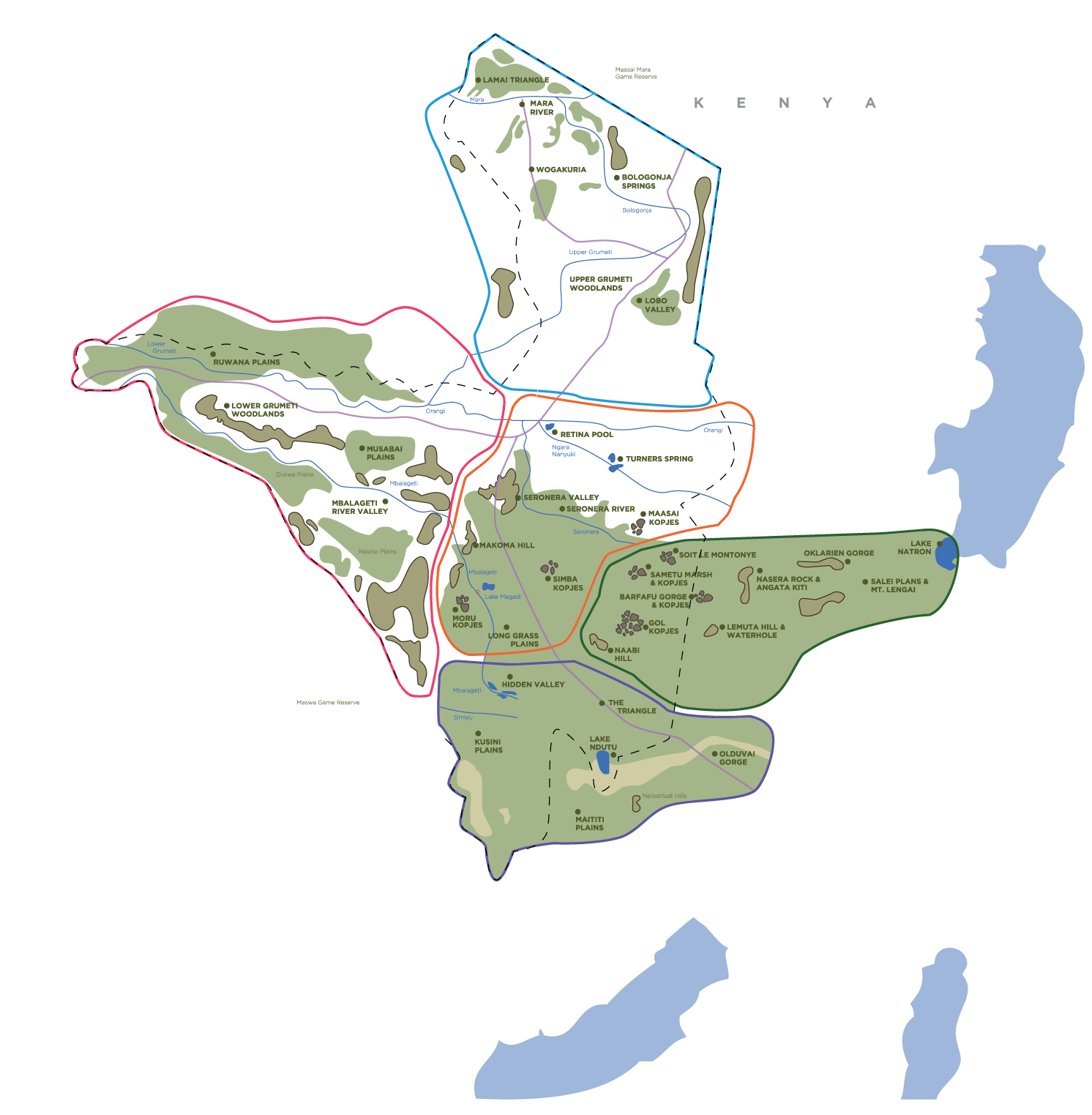
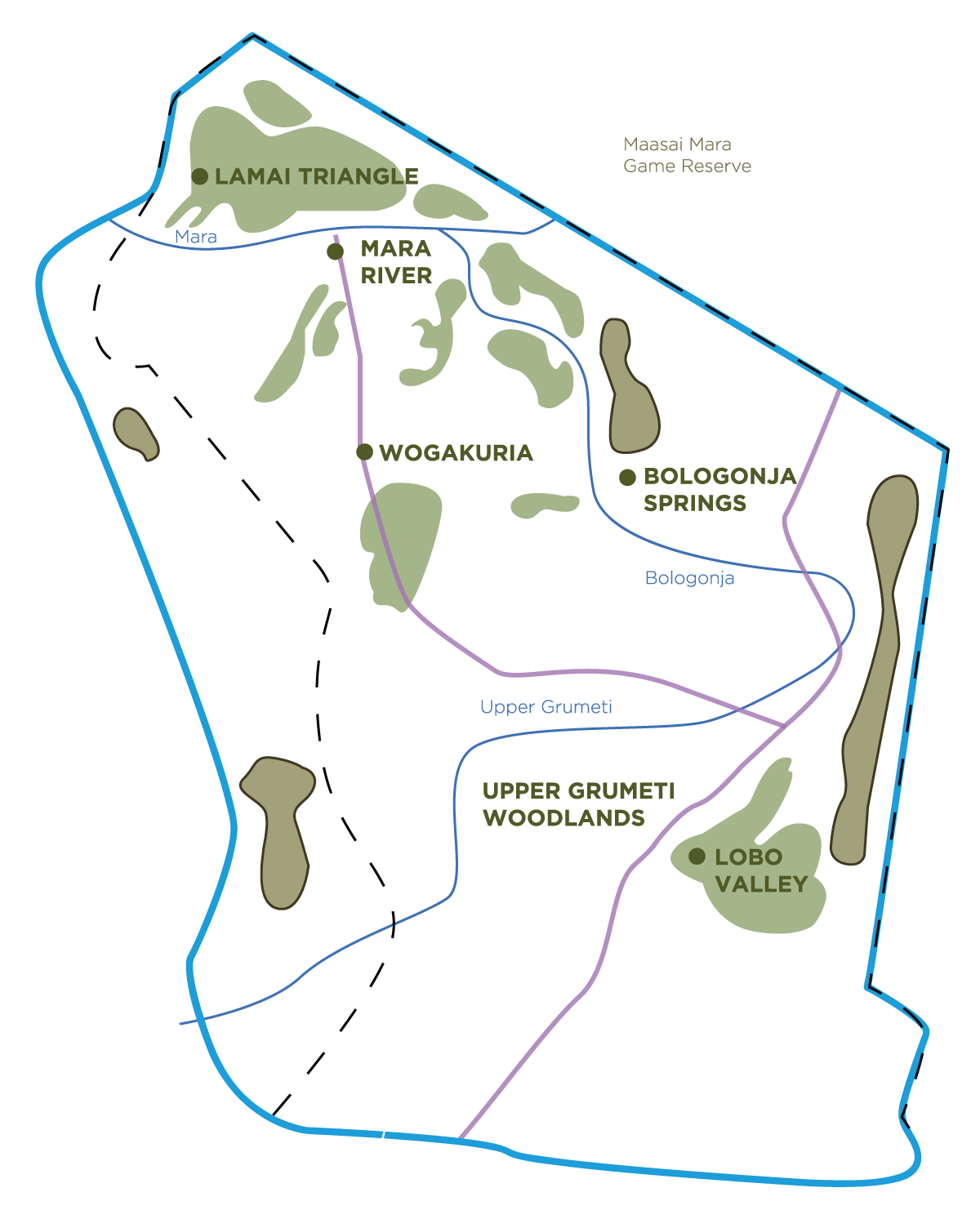
Northern Serengeti
Upper Grumeti Woodlands
The giraffe dominates the Upper Grumeti woodlands, feeding exclusively on the tender leaves of acacia trees. With the Grumeti River flowing across the top half of the Serengeti, before emptying into Lake Victoria, a distinctive gallery forest lines the banks of Grumeti River. This green and lush habitat supports species such as hippos, monkeys, baboons and fish eagles.
Bologonja Springs
With ample shade and fresh water, both migrating and resident animals are attracted to the lush and idyllic springs of Bologonya. Its flourishing resources also support some rare antelope species, including the elusive mountain reedbuck and steenbok. The centerpiece of Bologonja Springs is the Larelemangi Salt Lick, a haven for wildlife, especially for large herds of buffalo and elephant.
Wogakuria
Comprising of mostly open grasslands and studded with smooth granite kopjes, Wogakuria supports the highest concentration of cheetahs in Northern Serengeti while the surrounding broad-leaf woodlands sustain the rare and beautiful oribi antelope. Just northeast of the plains lies Wogakuria Kopjes, home to old buffalo bulls and the surefooted klipspringer antelope.
Mara Rivers
Famous for the legendary wildebeest river crossing and featured in countless wildlife documentaries, the Mara River hosts the most amazing spectacle in Africa. One of Tanzania’s best kept secret is the fact that nearly half of the Mara River is situated in the North Serengeti versus Masai Mara’s segment in Kenya. Birding along the Mara River include fish eagles, kingfishers, bee-eaters, weavers, and rare turaco.
Lamai Triangle
This triangular shaped watershed area, consisting of lush grassland with rolling hills and tree-lined waterways, is a critical refuge for migrating wildlife. During the dry season, the secluded Lamai Triangle holds more of the migration than the more tourist-heavy Masai Mara game reserve.
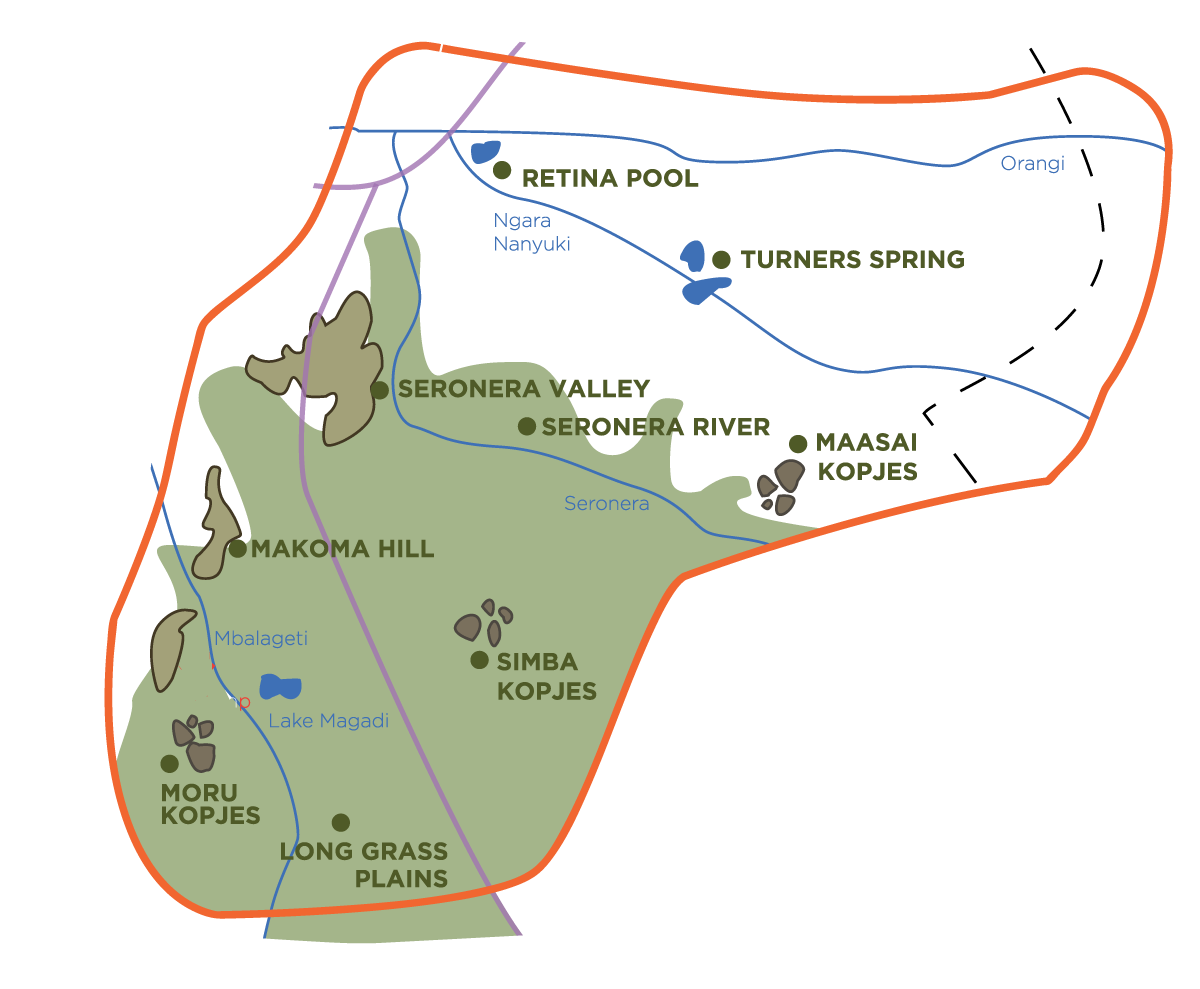
Central Serengeti
Seronera Valley
With a network of river valleys supplying a stable source of water, the Seronera Valley is home to the world’s largest and most diverse wildlife population of predators in the world. There is simply no better place to observe large carnivores in the wild along with a multitude of smaller predators like the jackal, bat-eared fox, serval and sandy-coloured caracal.
Turner Springs
Turner’s Spring was named after Myles Turner, a once chief wildlife warden in Serengeti National Park from 1956 to 1972. Due to Myles Turner’s continuous dedication for sustainable conservation and anti-poaching efforts, the large herds of wildlife within Africa’s finest wildlife sanctuary still roam free today. During dry season, Turner Springs is a magnet for wildlife.
Retina Pool
The Retina Pool offers the best hippo viewing in the Serengeti. You can leave the vehicle and view the hippos on foot from the top of the riverbank. Roughly 200 hippos are huddled together, playing, spouting, grunting in the deep pool of water, ensuring excellent photography and video opportunities.
Simba Kopjes
Simba Kopjes are the tallest kopjes in Serengeti and refuge for life as they provide excellent vantage points to survey the surrounding area for food sources. As the name ‘Simba’ suggests, this is great place to spot lions, oftentimes found basking under the sun.
Seronera River
With seasonal swamps and deep pools of water, the Seronera River keeps the vegetation plentiful, supporting the surrounding wildlife throughout the year. This is a good hunting ground for lions as they patiently wait at the base of the river to ambush their prey. The elusive leopards are also commonly spotted, usually resting in the branches of sausage trees.
Makoma Hill
There is tremendous conflict in this prey-rich area between the predators due to their overlapping territories. Directly in front of the hill lies a small but idyllic plain, which is used extensively by cheetahs and hyenas. The centerpiece of the plains lies the stunning Thatch Kopjes, a popular den site for the resident lion pride.
Moru Kopjes
The Moru Kopjes is home to the small population of the endangered black rhinos in the park. Be sure to also head to Gong Rock and see a series of Maasai rock paintings. The nearby saline Lake Magadi offers good sightings of pink flamingos.
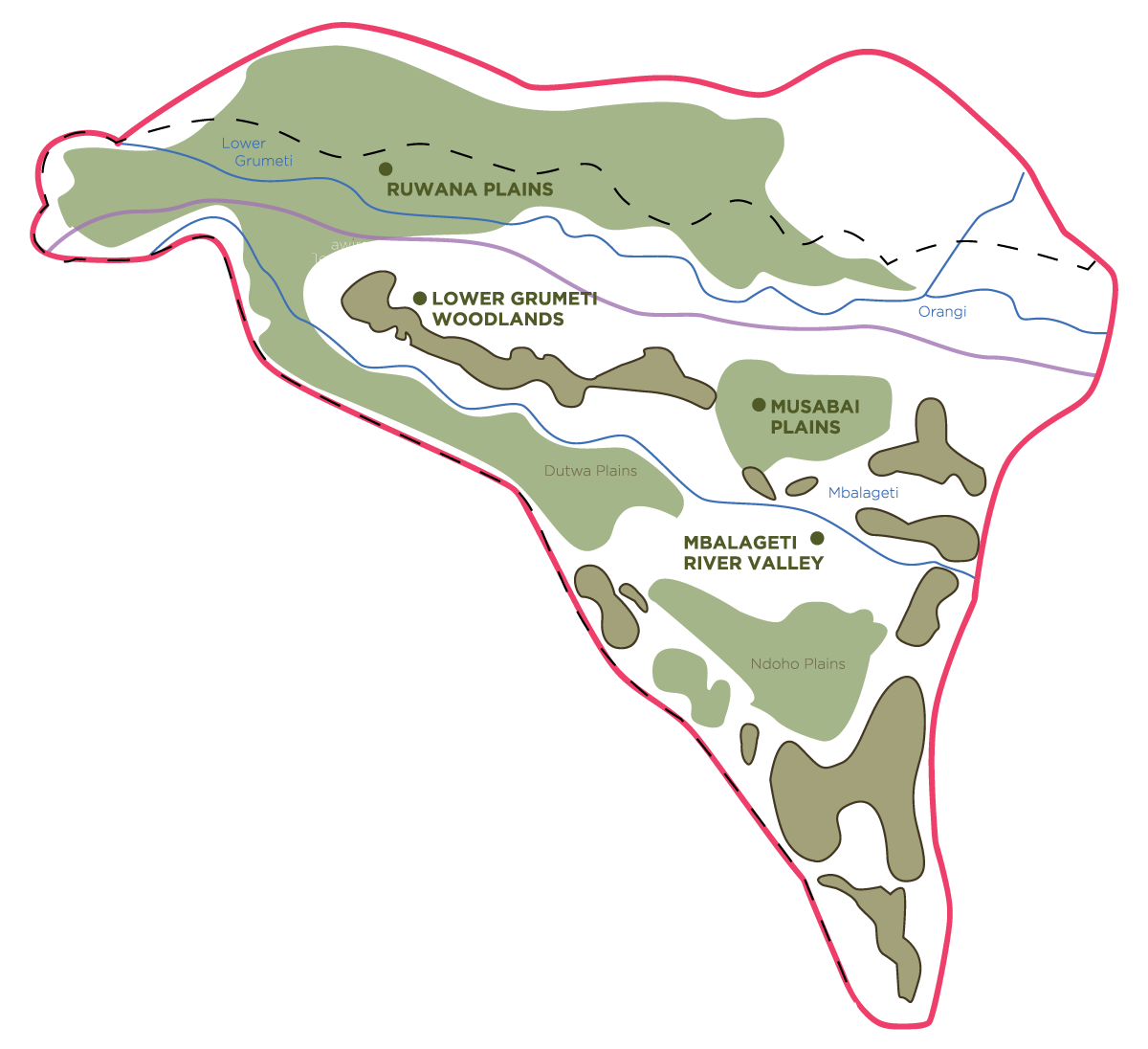
West Serengeti
Mbalageti River Valley
The Mbalageti River Valley links the plains to the woodlands and forms a
natural corridor. This area consists of a thicket of acacia trees interspersed with disintegrated woodlands and open plains. Although less ventured by those visiting the Serengeti, the Western Corridor retains a substantial resident population of lion, wildebeest and zebra, and overall offers decent game viewing year round.
Grumeti Woodlands
Every year, thousands of migrating wildebeests and zebras take the cold plunge and cross the raging waters of the Grumeti River. Large predators such as Nile crocodiles, leopards and lions lie in wait for those injured in the effort, too weak for the strong currents or who get stuck in the muddy quagmire at the river’s edges. The lush tangled forests and thickets that shade the river is also home to the black-and-white colobus monkey.
Musabi Plains
Musabi is an extensive area of plains covered by acacia woodlands and a favored breeding ground of the topi antelope. The Musabi plains are also in areas of unimpeded drainage on black cotton soil, which when wet, make travel by car exceedingly difficult. Giraffes, elephants and warthogs are also commonly found here.
Ruwana Plains
There are two resident lion prides that inhabit the Ruwana Plains. Several large clans of hyena maintain territories within Ruwana and can frequently be seen hunting or battling with neighboring clans. The Ruwana waterhole is a unique spot to witness both lion and hyena hunting especially in the dry season.
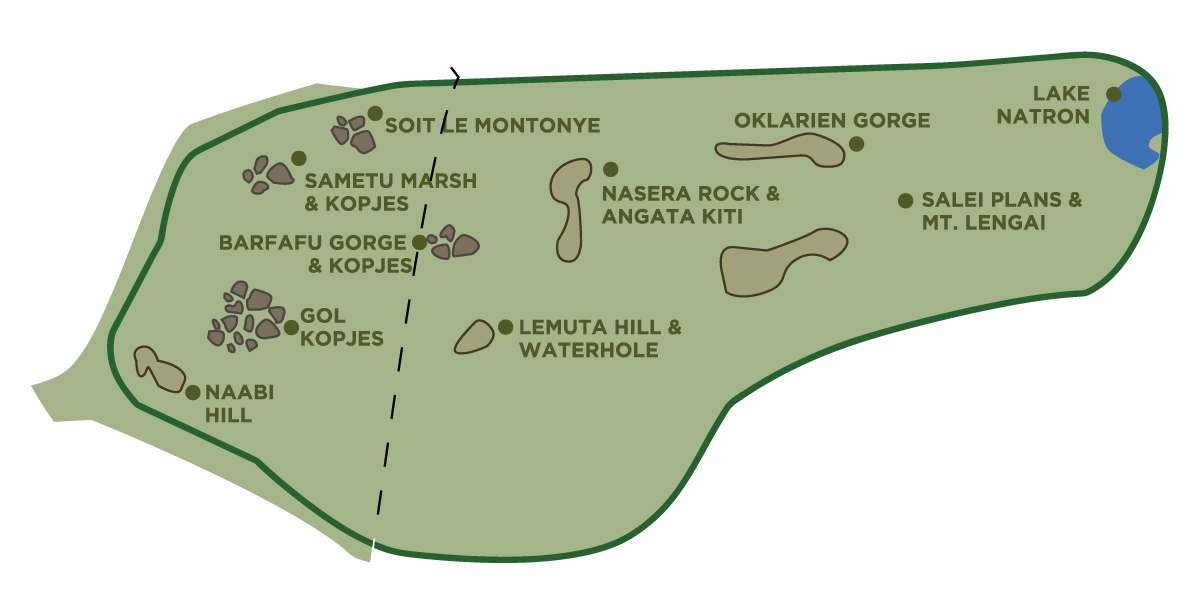
East Serengeti
Naabi Hill
This hill blanketed by acacia trees acts as the Serengeti’s park gate and shelters antelope, elephant and giraffe. It’s also the home base for the Naabi lion pride and den site for cheetahs. During the green season, Naabi Hill is the epicenter of the great migration.
Gol Kopjes
The Gol Kopjes boast the highest concentration of cheetahs in Africa and offering the finest game viewing during the green season. With a little patience, there is a good chance to witness the world’s fastest land animal sprinting across the plains in pursuit of the fleet footed Thomson’s Gazelle.
Barfafu Gorge & Kopjes
Barafu Kopjes Complex, a series of seven pinkish granite kopjes that straddle the eastern border of the Serengeti
Sametu Marsh & Kopjes
Sametu Kopjes is a hidden gem on the remote edge of the Serengeti. The marsh, which lies directly in front of the kopjes, is fed by underground springs, attracting surrounding wildlife as it holds the only source of water in the area.
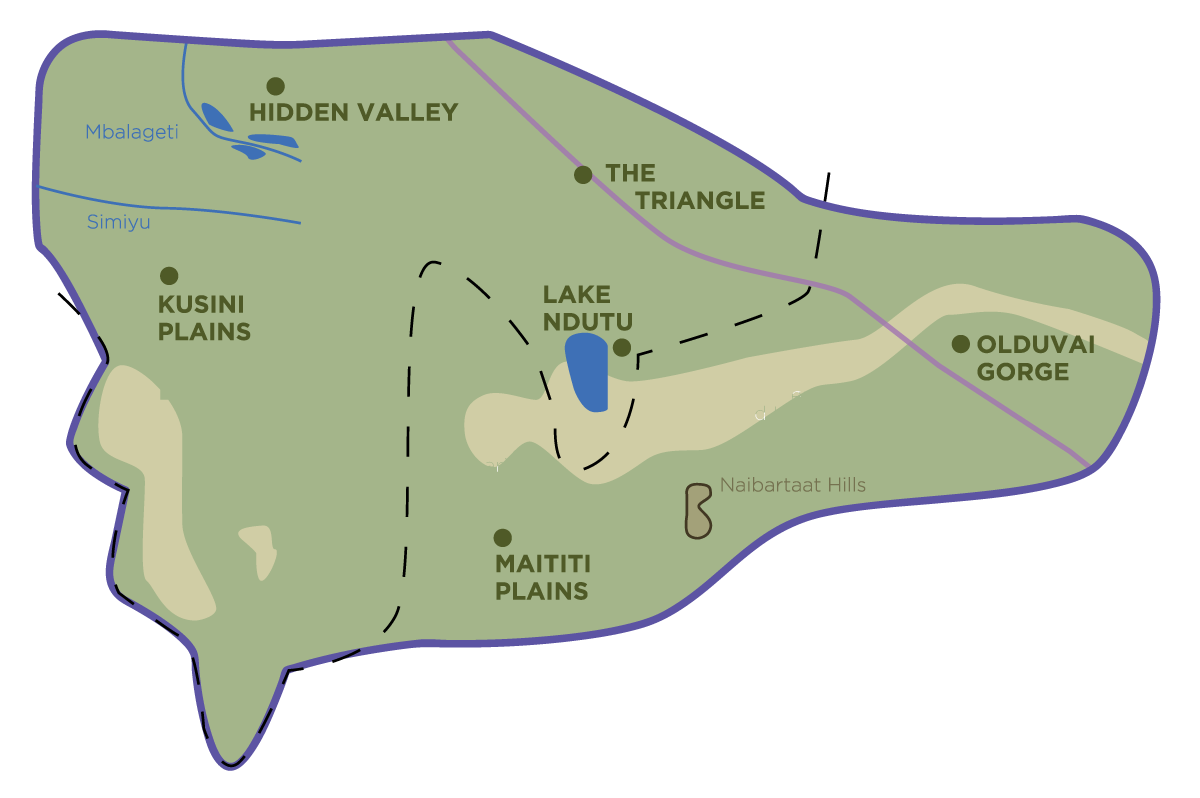
South Serengeti
Lake Ndutu
Ndutu comes to life during the green season, offering incredible wildlife and migration sightings. During a short time frame in February, typically only lasting 2-3 weeks, the majority of the wildebeest calves, hence the ‘calving season’. Thousands of wildebeest calves are born every day and can run within minutes after their birth.
Kusini Plains
Kusini plains consists of a unique combination of grasslands, woodlands and kopjes complimented by overlapping habitats of different species, including cheetah, honey badger, golden-backed jackal and hyena. Besides the migratory wildlife, Kusini boasts abundance of resident animals including elephants, giraffes, buffalo and lions and also known for its high concentration of cheetahs.
The Triangle
This short grass plains in this triangular shaped area hosts high densities of wildlife, including golden jackal, hyena, wildebeest, zebra, migratory storks and serval cat. This is the main feeding grounds of the migration for both migratory herbivores and predators following the herds. Due to the lack of a permanent water source, these plains are short-lived and withers at the onset of the dry season.
Matiti Plains
Elevated above the Matiti Plains are the ‘Twin Hills’, a Serengeti landmark. The beautiful Matiti plains that surround Twin Hills are home to huge female herds of wildebeest during the green season. This is the main plain that the wildebeest use for calving from January to March. Unlike most antelopes who seek cover when giving birth, pregnant wildebeest gather on the most open terrain available.
Hidden Valley
During the green season, a waterhole forms at the center of the valley, becoming a wildlife hub. With thousands of animals flocking into the area, predators such as hyenas are commonly seen lurking about. This valley is an ecologically sensitive area. Access may be occasionally restricted.
Olduvai Gorge
Olduvai Gorge, also known as the ‘Cradle of Mankind’, is a canyon carved by water through southern Serengeti and holds the earliest evidence of our human ancestors. Here, you can learn about archaeology, history and our ancient hominid ancestors at museum.

